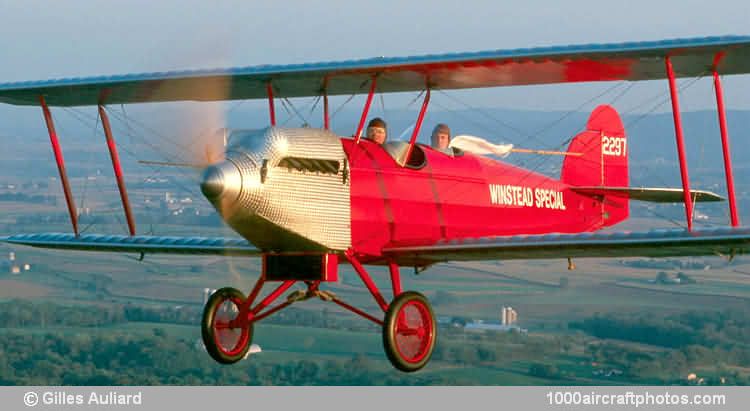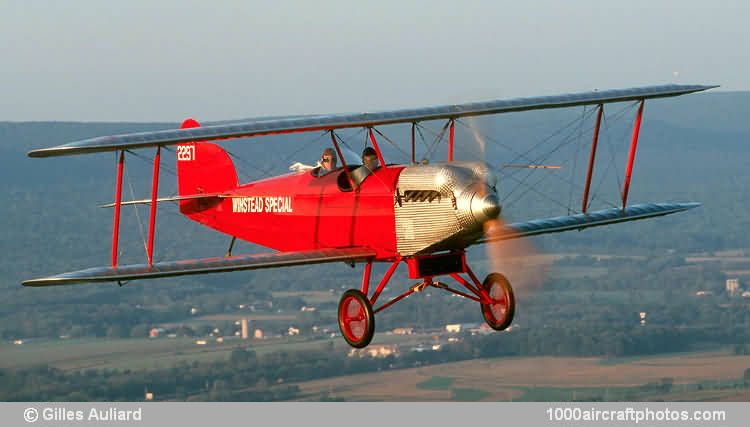11/28/2002. Remarks by Gilles Auliard, information by owner Paul Dougherty, Jr.: "The Winstead Special was certified in 1926 at the start of the Air Commerce Act. The Act stated that all aircraft and airmen will be licensed. The airplane was probably built between 1924 to 1925. The story is very historic. Walter Beech and Lloyd Stearman were working for Jake Molendick at Swallow Aircraft. Swallows were all wood construction up to this point, around 1924. Stearman and Beech decided to design and build a steel tube airplane: after all the Germans had done it during WWI. They built the fuselage with their own time and money, then took it to Molendick. Molendick said, "No way, our customers trust wood and that's what they will get."
Stearman and Beech decided to start their own company, and with the help of Clyde Cessna and his money, and Travel Air was born. When Stearman and Beech left Swallow the airframe was put up for sale. Carl Winstead was a mechanic for Swallow and he and his brother Guy purchased the fuselage to create the Winstead Special.
The fuselage it could be said was the first Travel Air. It does have the same dimensions as the Travel Air 2000, except the engine mount is of Swallow design and the wings attach differently. The wings are also of Swallow design and shape but do not match any known Swallow dimensions. They attach to the fuselage with vertical bolts running through the spars and the fittings pretty well match Swallow. The tail is the Winstead's design. It has an aluminum tube for the front horizontal stabilizer spar and the rest is steel tube. In early photos the tail was braced with only one set of brace wires. It probably wobbled quite a bit and they added a second set of wires soon after the initial flights. The landing gear vees were purchased from Nicholas Beasley Co. of Marshall, Missouri, USA. According to the Winstead family, the airplane had a radial engine prior to the OX-5.
Carl Winstead flew the Special with the Flying Aces Air Circus in the late 1920s. Jessie Woods wing walked the airplane in the shows. Carl also barnstormed the airplane. It was sold to Marvin Mara in 1930 who used it for barnstorming and, believe it or not, air racing. It changed hands several times after that. In 1937 J.J. Davis of Ayre, Nebraska, determined that it was not airworthy and took it apart for storage where it remained until the late 1980s. The Davis family sold it to a gentleman from Michigan who traded it to the Air Power Museumin Blakesburg, Iowa, USA.
Carl and Guy Winstead went on to do some great things in aviation. Carl was one of Cessna's first employees, building the A series. He later became Cessna Chief Test Pilot; he was killed in the mid-1940s testing the 195 prototype. Guy Winstead also helped Clyde Cessna build the prototype Travel Air 5000.
My Father, Paul Sr., and I purchased the Special in 1995. The restoration was very extensive. Damage could be seen in the center section from wing walkers. The lower ailerons were replaced. Much of the steel tubing in the forward part of the fuselage was replaced. The only things missing from the airplane prior to the restoration were the vertical fin and rudder, and the seats. We recreated the fin and rudder from photographs because no blue prints exist. The total restoration time was close to 4 years. It has been flying now for over three years.
The Special flies very nicely. The OX-5 puts out plenty of power for the airplane. The climb rate is respectable for an airplane of this vintage. The four ailerons give it a modest roll rate. You would think it would be faster for a short wing and four ailerons. The elevator is very responsive; it does not have any stabilizer or elevator trim. It can be changed by removing the attachment bolts and changing washers.
The stick forces do not change too badly whether there is one person or three aboard. The rudder is also very responsive, and it works very well to taxi. The airplane does not have brakes or a steerable tail skid so the rudder is all you have. It will turn around very well in about 150 ft (46 m) of taxiway. The take off distance is not much, depending on load, temperatures, etc., using only from 400 to about 800 ft (122 to 244 m) of runway. Take off rpm is about 1400, and cruise is 1350 to 1400. Flat out in cruise the engine will turn 1525 rpm. We have never had an over heating problem, even on the hottest days. Landing rolls are also very short: the tail skid acts as a very efficient brake.
Handling in the air is much more nimble and has a lighter feel than a Travel Air. Formation flying is interesting because it takes a lot of coaxing to accelerate. The 90 hp Curtiss OX-5, with Berling magneto, is running at very close to full power during cruise leaving very little for acceleration. The OX-5 engine is one of the smoothest engines I have ever flown behind.
To sum it up I feel very privileged to own and fly this beautiful airplane.

